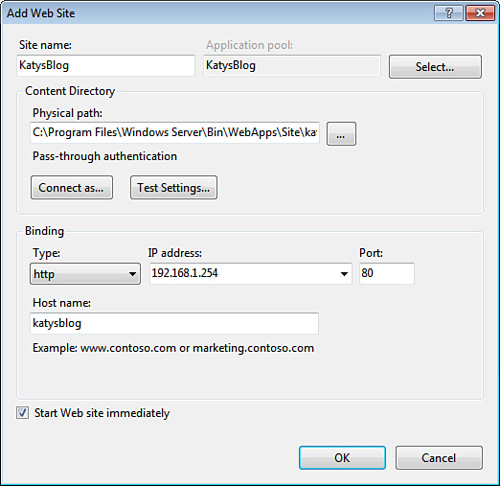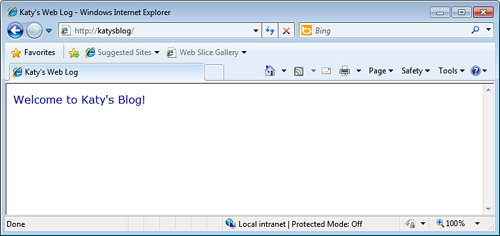3. Creating a New Website Using a Host Header
When
a web browser opens a TCP communications channel with a web server, the
HTTP data that is passed to the server comes with a header that
includes information such as the date and a string that identifies the
browser. The header also includes a hostname field, which identifies
the location of the resource the browser seeks. The host header is
usually either a domain name (for an Internet connection) or a network
name (for a LAN connection).
Interestingly, it’s also possible to make up a
hostname of your own choosing: KatysBlog, FamilyWeb, or whatever. You
can then create a new website and use a custom hostname as the identity
of your site.
Associating the Host Header with an IP Address
Custom host headers work because you map them to an IP address. As before, you can set up the mapping yourself by editing the hosts file, and you can set up both local and remote mappings. Remember that you must edit the hosts
file on Windows Home Server and on every computer that you want to give
access to the site. (So, as before, this method only really works for
your local computers, not for anyone outside your network.)
You modify the hosts file in the same way that I described in the earlier section. That is, you open the hosts file, start a new line at the end of the file, and then enter the mapping using the following general format:
In this case, you replace IP with the IP address of your Windows Home Server PC, and you replace hostheader
with the host header name you want to use for the website. In the
following example, I’ve assigned both a local name and a subdomain name
to 192.168.1.254:
192.168.1.254 katysblog
192.168.1.254 katysblog.ourfamily.homeserver.com
Creating a Website Using a Host Header
Here are the steps to follow to create a website that uses a host header:
1. | In IIS Manager, open the SERVER, Web branch (where SERVER is the name of your Windows Home Server PC).
|
2. | In the Actions pane, click Add Web Site. IIS Manager opens the Add Web Site dialog box.
|
3. | Use
the Site Name text box to type a name for the website. This is the name
that appears in IIS Manager, within the Sites branch.
|
4. | Either
type the full pathname (drive and folders) in the Physical Path text
box, or click Browse and use the Browse for Folder dialog box to either
select the folder or create a new folder.
|
5. | In the IP Address list, select the main IP address assigned to your Windows Home Server PC. Leave the Port value as is.
|
6. | Use the Host Name text box to type the host header, as shown in Figure 10.

|
7. | Click OK. IIS Manager adds the new site to the Sites branch.
|
From here, add content to the folder you specified in step 4, including a file that uses one of the IIS default names. Figure 11 shows Internet Explorer displaying a new website using the host header katysblog (http://katysblog).
